Abstract
The history of the development of influenza virus vaccine is traced from its origin with experimental studies of influenza virus in ferrets and mice and the first trials in man. Knowledge of the basis of immunity to the viruses in experimental animals and in man has grown steadily over the years and has been essential to successful immunization. Virus variation affecting the surface antigens of the virus is seen as the principal obstacle to the application of vaccines in man. So significant are the changes occurring during antigenic drift that former concepts of a polyvalent vaccine cannot provide a solution of the problem of the composition of vaccines. Disrupted virus vaccines appear to provide the answer to the prevention of vaccine reactions.
Full text
PDF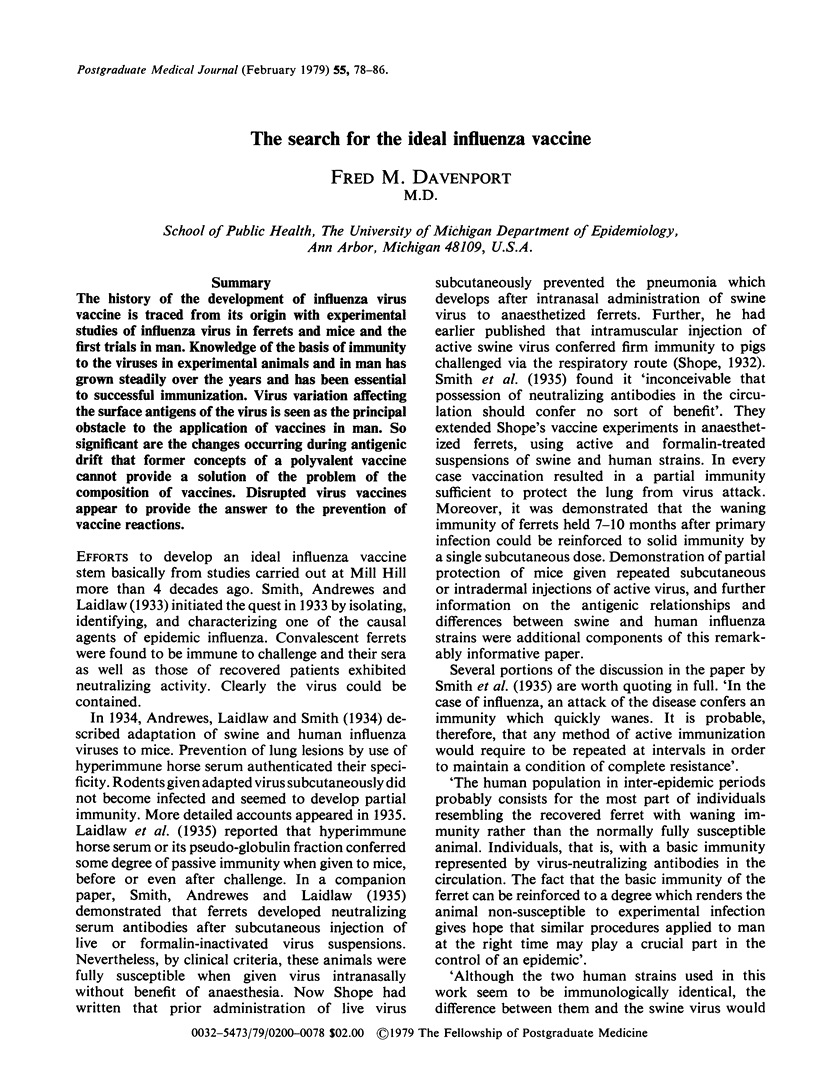
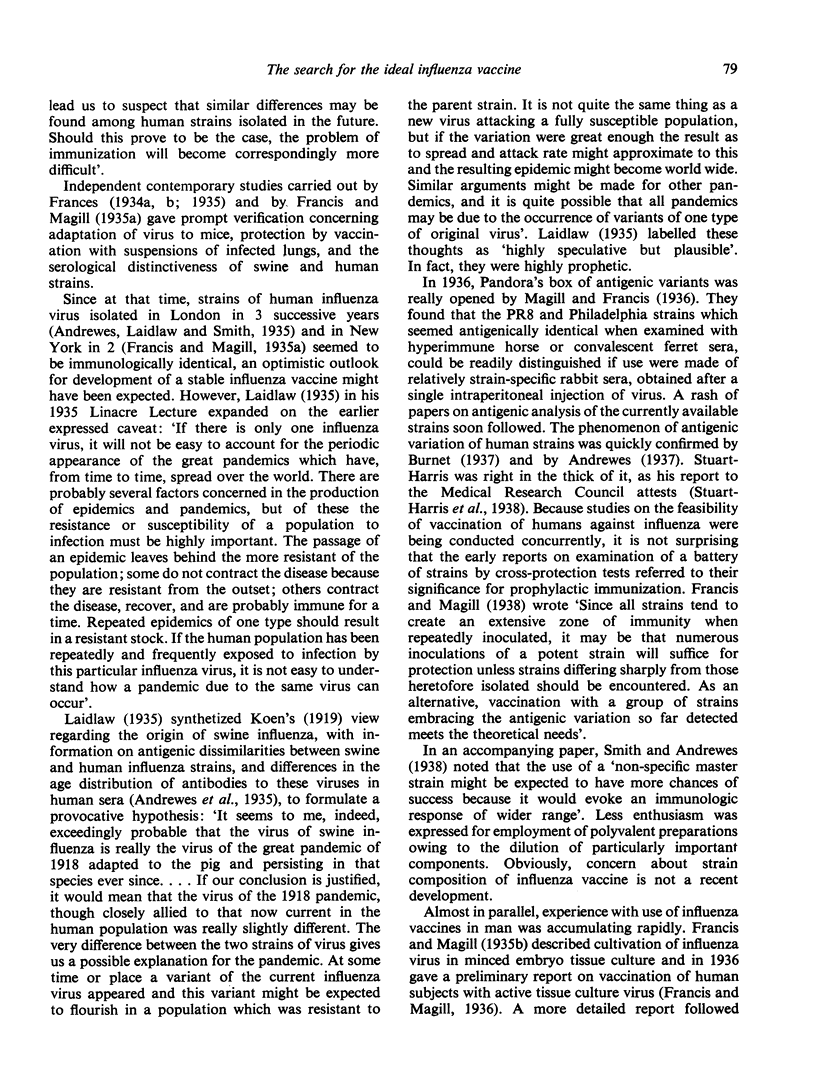
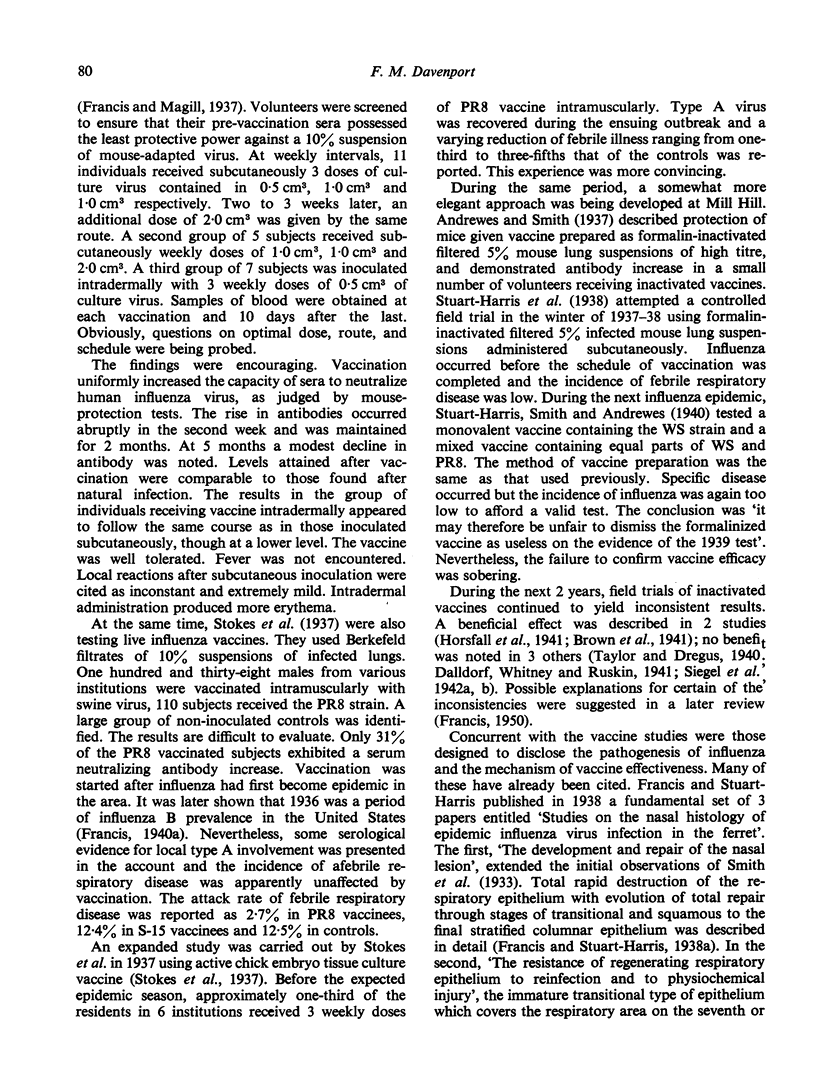
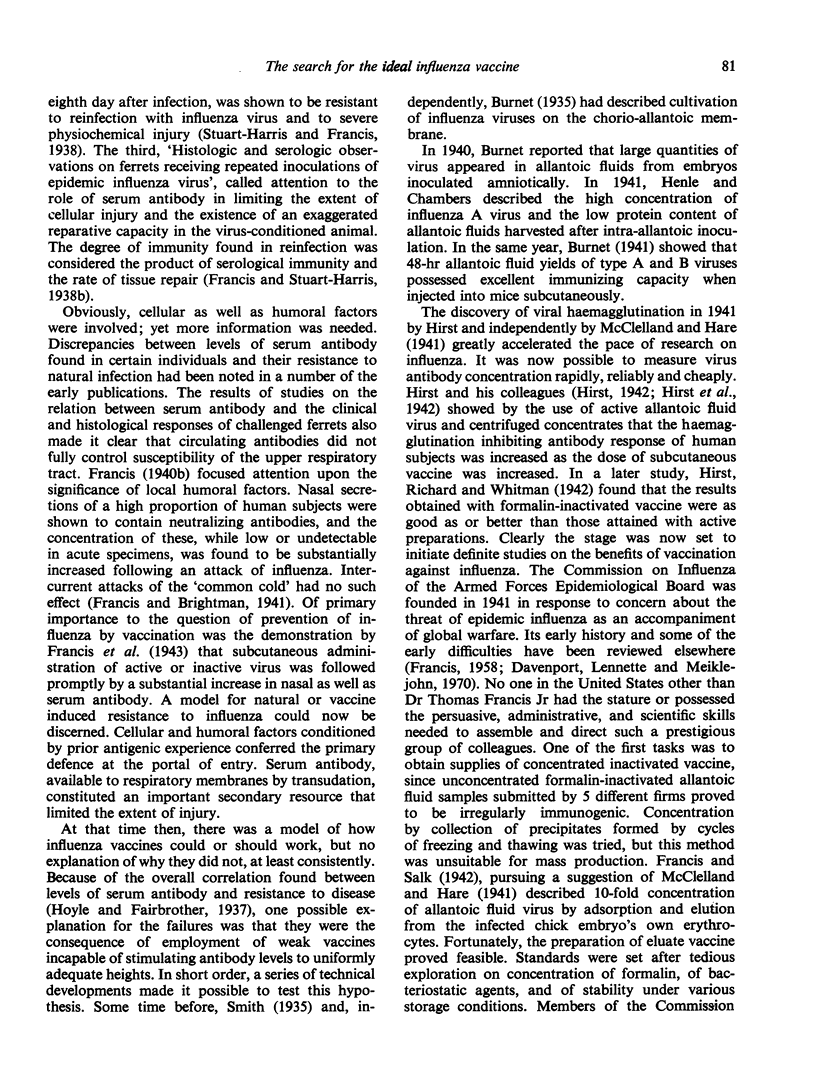
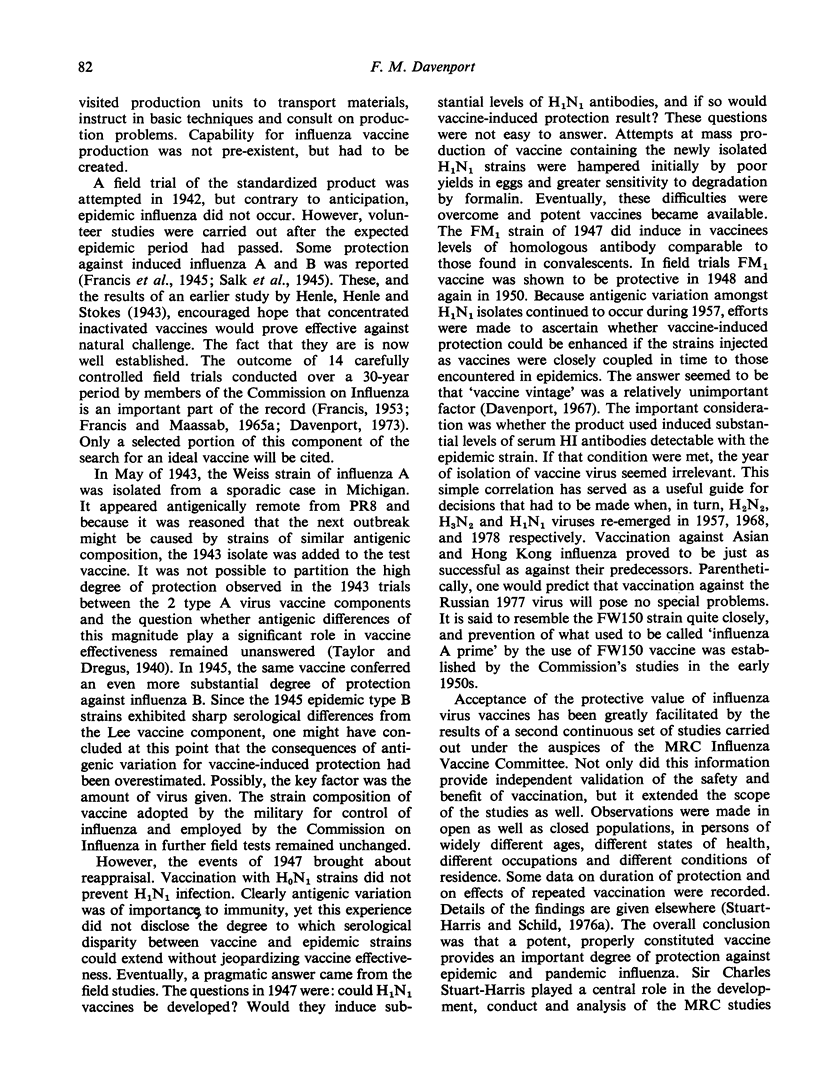
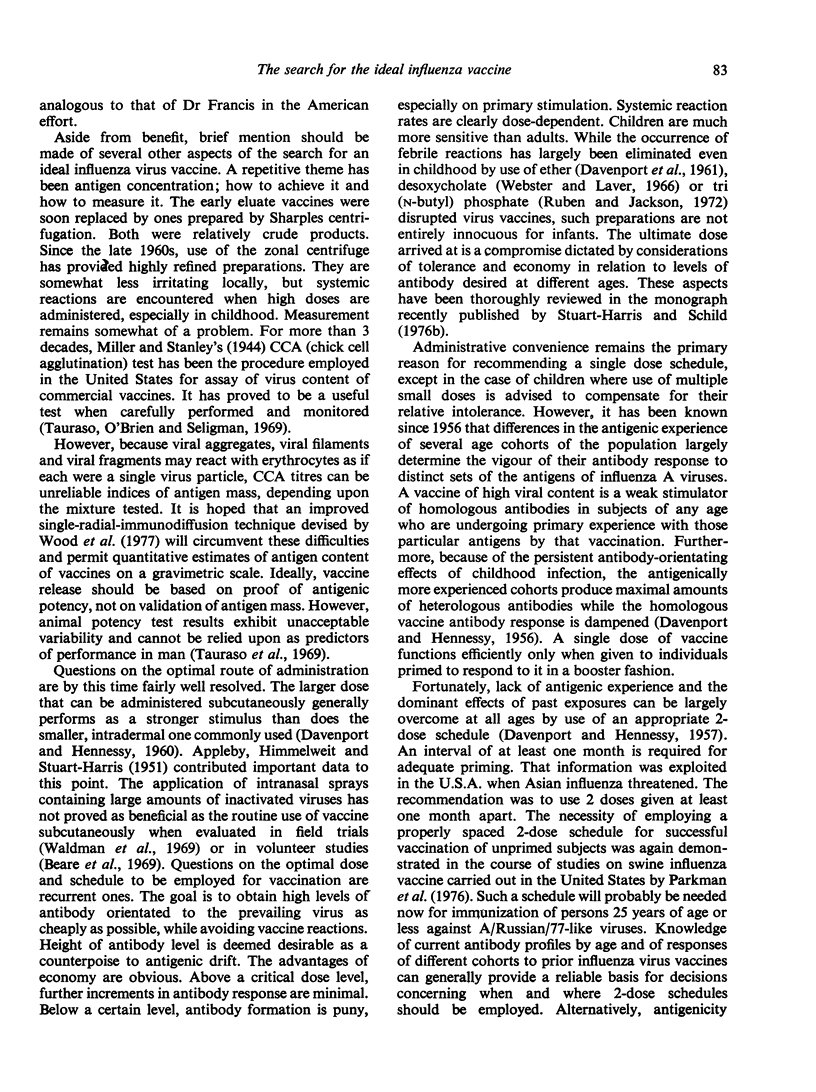
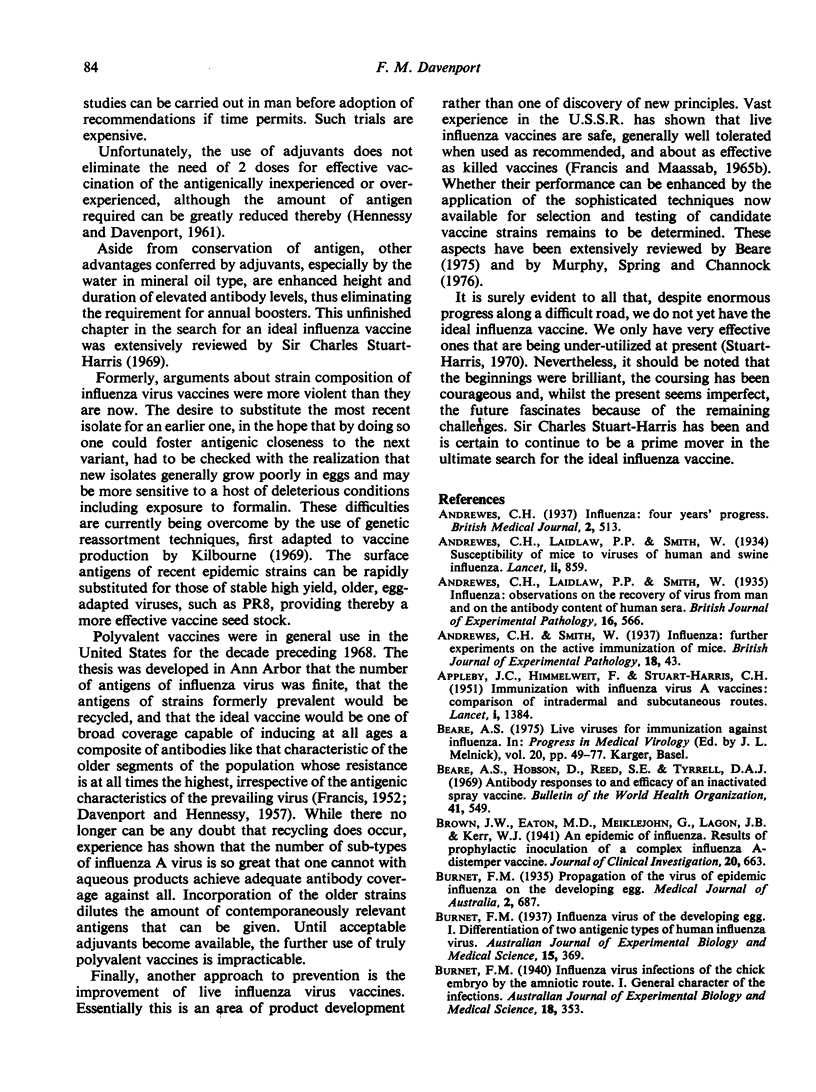
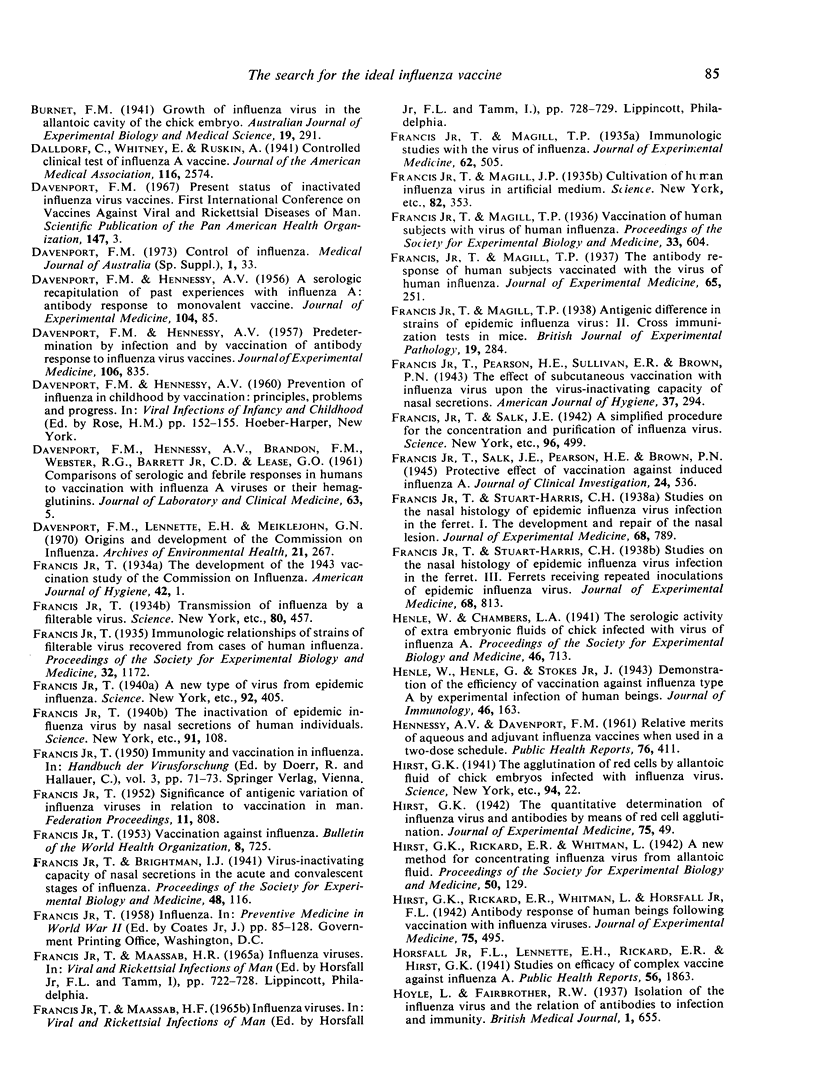
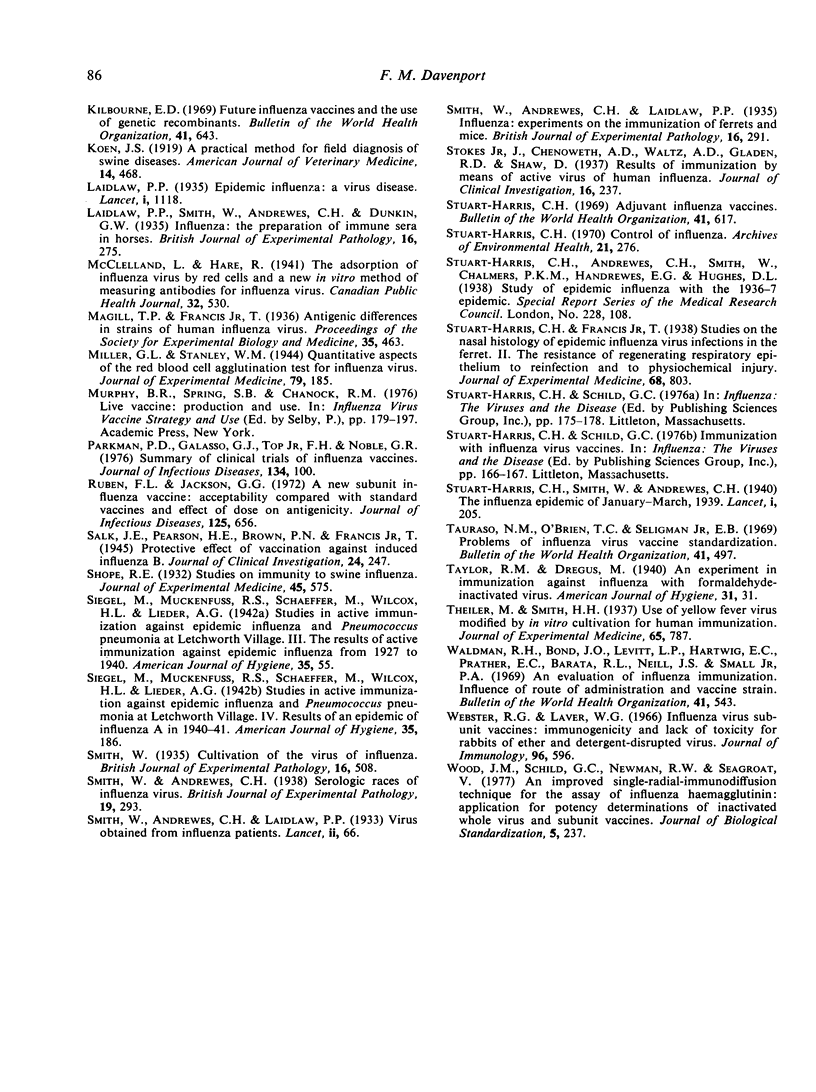
Selected References
These references are in PubMed. This may not be the complete list of references from this article.
- APPLEBY J. C., HIMMELWEIT F., STUART-HARRIS C. H. Immunization with influenza virus A vaccines. Comparison of intradermal and subcutaneous routes. Lancet. 1951 Jun 30;1(6670):1384–1387. doi: 10.1016/s0140-6736(51)92840-1. [DOI] [PubMed] [Google Scholar]
- Andrewes C. H. Influenza: Four Years' Progress. Br Med J. 1937 Sep 11;2(4001):513–515. doi: 10.1136/bmj.2.4001.513. [DOI] [PMC free article] [PubMed] [Google Scholar]
- Beare A. S., Hobson D., Reed S. E., Tyrrell D. A. Antibody responses to and efficacy of an inactivated spray vaccine. Bull World Health Organ. 1969;41(3):549–551. [PMC free article] [PubMed] [Google Scholar]
- Brown J. W., Eaton M. D., Meiklejohn G., Lagen J. B., Kerr W. J. AN EPIDEMIC OF INFLUENZA. RESULTS OF PROPHYLACTIC INOCULATION OF A COMPLEX INFLUENZA A-DISTEMPER VACCINE. J Clin Invest. 1941 Nov;20(6):663–669. doi: 10.1172/JCI101259. [DOI] [PMC free article] [PubMed] [Google Scholar]
- DAVENPORT F. M., HENNESSY A. V. A serologic recapitulation of past experiences with influenza A; antibody response to monovalent vaccine. J Exp Med. 1956 Jul 1;104(1):85–97. doi: 10.1084/jem.104.1.85. [DOI] [PMC free article] [PubMed] [Google Scholar]
- DAVENPORT F. M., HENNESSY A. V. Predetermination by infection and by vaccination of antibody response to influenza virus vaccines. J Exp Med. 1957 Dec 1;106(6):835–850. doi: 10.1084/jem.106.6.835. [DOI] [PMC free article] [PubMed] [Google Scholar]
- Davenport R. M., Lennette E. H., Meiklejohn G. N. Origins and development of the commission on influenza. Arch Environ Health. 1970 Sep;21(3):267–272. doi: 10.1080/00039896.1970.10667237. [DOI] [PubMed] [Google Scholar]
- FRANCIS T., Jr Significance of antigenic variation of influenza viruses in relation to vaccination in man. Fed Proc. 1952 Sep;11(3):808–812. [PubMed] [Google Scholar]
- FRANCIS T., Jr Vaccination against influenza. Bull World Health Organ. 1953;8(5-6):725–741. [PMC free article] [PubMed] [Google Scholar]
- Francis T., Jr A NEW TYPE OF VIRUS FROM EPIDEMIC INFLUENZA. Science. 1940 Nov 1;92(2392):405–408. doi: 10.1126/science.92.2392.405. [DOI] [PubMed] [Google Scholar]
- Francis T., Jr, Magill T. P. CULTIVATION OF HUMAN INFLUENZA VIRUS IN AN ARTIFICIAL MEDIUM. Science. 1935 Oct 11;82(2128):353–354. doi: 10.1126/science.82.2128.353. [DOI] [PubMed] [Google Scholar]
- Francis T., Jr, Salk J. E. A SIMPLIFIED PROCEDURE FOR THE CONCENTRATION AND PURIFICATION OF INFLUENZA VIRUS. Science. 1942 Nov 27;96(2500):499–500. doi: 10.1126/science.96.2500.499. [DOI] [PubMed] [Google Scholar]
- Francis T., Jr TRANSMISSION OF INFLUENZA BY A FILTERABLE VIRUS. Science. 1934 Nov 16;80(2081):457–459. doi: 10.1126/science.80.2081.457-a. [DOI] [PubMed] [Google Scholar]
- Francis T., Magill T. P. IMMUNOLOGICAL STUDIES WITH THE VIRUS OF INFLUENZA. J Exp Med. 1935 Sep 30;62(4):505–516. doi: 10.1084/jem.62.4.505. [DOI] [PMC free article] [PubMed] [Google Scholar]
- Francis T., Magill T. P. THE ANTIBODY RESPONSE OF HUMAN SUBJECTS VACCINATED WITH THE VIRUS OF HUMAN INFLUENZA. J Exp Med. 1937 Jan 31;65(2):251–259. doi: 10.1084/jem.65.2.251. [DOI] [PMC free article] [PubMed] [Google Scholar]
- Francis T., Salk J. E., Pearson H. E., Brown P. N. PROTECTIVE EFFECT OF VACCINATION AGAINST INDUCED INFLUENZA A. J Clin Invest. 1945 Jul;24(4):536–546. doi: 10.1172/JCI101633. [DOI] [PMC free article] [PubMed] [Google Scholar]
- Francis T., Stuart-Harris C. H. STUDIES ON THE NASAL HISTOLOGY OF EPIDEMIC INFLUENZA VIRUS INFECTION IN THE FERRET : I. THE DEVELOPMENT AND REPAIR OF THE NASAL LESION. J Exp Med. 1938 Oct 31;68(6):789–802. doi: 10.1084/jem.68.6.789. [DOI] [PMC free article] [PubMed] [Google Scholar]
- Francis T., Stuart-Harris C. H. STUDIES ON THE NASAL HISTOLOGY OF EPIDEMIC INFLUENZA VIRUS INFECTION IN THE FERRET : III. HISTOLOGICAL AND SEROLOGICAL OBSERVATIONS ON FERRETS RECEIVING REPEATED INOCULATIONS OF EPIDEMIC INFUENZA VIRUS. J Exp Med. 1938 Oct 31;68(6):813–830. doi: 10.1084/jem.68.6.813. [DOI] [PMC free article] [PubMed] [Google Scholar]
- HENNESSY A. V., DAVENPORT F. M. Relative merits of aqueous and adjuvant influenza vaccines when used in a two-dose schedule. Public Health Rep. 1961 May;76:411–419. [PMC free article] [PubMed] [Google Scholar]
- Hirst G. K., Rickard E. R., Whitman L., Horsfall F. L. ANTIBODY RESPONSE OF HUMAN BEINGS FOLLOWING VACCINATION WITH INFLUENZA VIRUSES. J Exp Med. 1942 May 1;75(5):495–511. doi: 10.1084/jem.75.5.495. [DOI] [PMC free article] [PubMed] [Google Scholar]
- Hirst G. K. THE QUANTITATIVE DETERMINATION OF INFLUENZA VIRUS AND ANTIBODIES BY MEANS OF RED CELL AGGLUTINATION. J Exp Med. 1942 Jan 1;75(1):49–64. doi: 10.1084/jem.75.1.49. [DOI] [PMC free article] [PubMed] [Google Scholar]
- Hoyle L., Fairbrother R. W. Isolation of Influenza Virus: The Manchester Epidemic. Br Med J. 1937 Mar 27;1(3977):655–657. doi: 10.1136/bmj.1.3977.655. [DOI] [PMC free article] [PubMed] [Google Scholar]
- Kilbourne E. D. Future influenza vaccines and the use of genetic recombinants. Bull World Health Organ. 1969;41(3):643–645. [PMC free article] [PubMed] [Google Scholar]
- Miller G. L., Stanley W. M. QUANTITATIVE ASPECTS OF THE RED BLOOD CELL AGGLUTINATION TEST FOR INFLUENZA VIRUS. J Exp Med. 1944 Feb 1;79(2):185–195. doi: 10.1084/jem.79.2.185. [DOI] [PMC free article] [PubMed] [Google Scholar]
- Public Health Weekly Reports for SEPTEMBER 19, 1941. Public Health Rep. 1941 Sep 19;56(38):1863–1900. [PMC free article] [PubMed] [Google Scholar]
- Ruben F. L., Jackson G. G. A new subunit influenza vaccine: acceptability compared with standard vaccines and effect of dose on antigenicity. J Infect Dis. 1972 Jun;125(6):656–664. doi: 10.1093/infdis/125.6.656. [DOI] [PubMed] [Google Scholar]
- Shope R. E. STUDIES ON IMMUNITY TO SWINE INFLUENZA. J Exp Med. 1932 Sep 30;56(4):575–585. doi: 10.1084/jem.56.4.575. [DOI] [PMC free article] [PubMed] [Google Scholar]
- Stokes J., Chenoweth A. D., Waltz A. D., Gladen R. G., Shaw D. RESULTS OF IMMUNIZATION BY MEANS OF ACTIVE VIRUS OF HUMAN INFLUENZA. J Clin Invest. 1937 Mar;16(2):237–243. doi: 10.1172/JCI100853. [DOI] [PMC free article] [PubMed] [Google Scholar]
- Stuart-Harris C. H. Adjuvant influenza vaccines. Bull World Health Organ. 1969;41(3):617–621. [PMC free article] [PubMed] [Google Scholar]
- Stuart-Harris C. H. Control of influenza: lack of knowledge versus lack of application of knowledge. Arch Environ Health. 1970 Sep;21(3):276–285. doi: 10.1080/00039896.1970.10667239. [DOI] [PubMed] [Google Scholar]
- Stuart-Harris C. H., Francis T. STUDIES ON THE NASAL HISTOLOGY OF EPIDEMIC INFLUENZA VIRUS INFECTION IN THE FERRET : II. THE RESISTANCE OF REGENERATING RESPIRATORY EPITHELIUM TO REINFECTION AND TO PHYSICOCHEMICAL INJURY. J Exp Med. 1938 Oct 31;68(6):803–812. doi: 10.1084/jem.68.6.803. [DOI] [PMC free article] [PubMed] [Google Scholar]
- Tauraso N. M., O'Brien T. C., Seligman E. B., Jr Problems of influenza virus vaccine standardization. Bull World Health Organ. 1969;41(3):497–506. [PMC free article] [PubMed] [Google Scholar]
- Theiler M., Smith H. H. THE USE OF YELLOW FEVER VIRUS MODIFIED BY IN VITRO CULTIVATION FOR HUMAN IMMUNIZATION. J Exp Med. 1937 May 31;65(6):787–800. doi: 10.1084/jem.65.6.787. [DOI] [PMC free article] [PubMed] [Google Scholar]
- Waldman R. H., Bond J. O., Levitt L. P., Hartwig E. C., Prather E. C., Baratta R. L., Neill J. S., Small P. A., Jr An evaluation of influenza immunization: influence of route of administration and vaccine strain. Bull World Health Organ. 1969;41(3):543–548. [PMC free article] [PubMed] [Google Scholar]
- Webster R. G., Laver W. G. Influenza virus subunit vaccines: immunogenicity and lack of toxicity for rabbits of ether- and detergent-disrupted virus. J Immunol. 1966 Apr;96(4):596–605. [PubMed] [Google Scholar]
- Wood J. M., Schild G. C., Newman R. W., Seagroatt V. An improved single-radial-immunodiffusion technique for the assay of influenza haemagglutinin antigen: application for potency determinations of inactivated whole virus and subunit vaccines. J Biol Stand. 1977;5(3):237–247. doi: 10.1016/s0092-1157(77)80008-5. [DOI] [PubMed] [Google Scholar]


